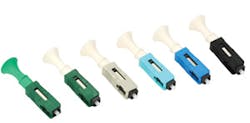New products and technologies offer flexibility, economy and reliability.
By Jerry Jackson, 3M Communication Markets Division
For fiber-to-the-home (FTTH) network deployments, drop-cable connectivity products are just as important as the fiber itself. Failed connections lead to service outages and expensive service calls, so choosing the right connectivity solution ranks high among considerations service providers face when building a reliable and profitable network.
Yet finding the right connectivity solution for a particular deployment situation can prove to be a daunting task. Deciding between field- and factory-terminated products is one of the initial choices providers must make before deployment begins. Both alternatives have their pros and cons.
Over the last several years, the industry has trended away from field termination in favor of factory-terminated products. Factory termination is generally believed to produce a higher-performing connection than field-terminated connections. The controlled factory termination dramatically reduces the risk of contaminants marring the fiber cable and ensures more-consistent, reliable endface geometry, resulting in low insertion loss and attenuation. Factory termination also keeps labor costs low by reducing installation and technician training time compared to field termination.
Conversely, some providers have continued to opt for field-termination methods due to their flexibility. Using factory-terminated products requires an inventory of varying lengths of patch cords for different installation scenarios, whereas field termination uses less-expensive bulk cable, which is cut to length on-site. Field termination also eliminates the need to devise slack cable-management systems for each installed home—a necessity when using predetermined lengths of factory-terminated patch cords. And, with factory-terminated products, technicians run the risk of being caught in the field without the proper length of patch cord, causing installation delays and adding to labor costs.
Service providers choosing field-terminated methods of connectivity face another choice: fusion or mechanical splicing? Until recently, the choice was clear. For decades, providers overwhelmingly preferred fusion splicing for its consistent delivery of reliable connections. However, recent technical advances have opened up a broader array of less-costly options that offer the same level of reliability as fusion splicing.
Many providers harbor a concern that the index matching gel inside mechanical splices can yellow or dry out, resulting in service failures. However, over the last 20 years great strides have been made across the industry in improving gel performance and longevity.
For example, testing shows that the gel used in our No Polish Connector (NPC) can perform well in temperature extremes from -40 to 167 degrees Fahrenheit. Extensive third-party optical, environmental and mechanical tests demonstrated that the NPC is a highly reliable, cost-effective product for FTTH deployments. In fact, service providers in Japan have deployed more than 10 million of our mechanical splices and connectors, including the NPC, both indoors and outdoors.
Providers beyond Japan are now beginning to choose mechanical splicing because of its lower total installed cost compared to fusion splicing and its improved reliability. One major U.S. provider reduced its capital expenditure, installation time and total installation cost by 50 percent when it switched from fusion splices to the NPC.
Fusion splicing is expensive compared to mechanical splicing methods. Fusion splicing machines sell for thousands of dollars apiece, requiring a heavy investment to equip each technician in the field. Additionally, the machines require electrical power, such as a battery, which can deplete of charge in the field, adding time and cost to the process. Moreover, fusion splicing can be time-consuming and requires specially trained technicians, further impacting costs.
The NPC is installed with a simple handheld tool that does not require an electrical power source. Terminating fiber cable using the connectors requires little training. A single-fiber termination can be completed in three minutes with the NPC.
In cases where providers prefer field over factory-terminated products, they now have more choices and greater flexibility. Mechanical connectivity methods have advanced to offer highly reliable connections. Whether choosing a product with gel or without, mechanical connectivity provides a cost-effective, reliable alternative for FTTH drop-cable installations.
Jerry Jackson is market-development manager with 3M’s Communication Markets Division.
Jettisoning the gelFor those who remain uncomfortable with a gel splice, another alternative now exists. 3M offers the Crimplok+ Connector, a commercially available FTTX field-mounted fiber connector that meets indoor and outdoor performance requirements without a splice, gel or adhesive.
Service providers have reduced operating and capital-expenditure costs when they replace fusion splices with these connectors. The equipment savings can be 75 percent or more, and labor savings run 20 to 50 percent depending upon the deployment environment.
The connector combines the performance of fusion splice-on connectors with the speed of mechanical-splice connectors. The SC/APC-compatible connector can be installed in indoor or outdoor locations while maintaining optical reflections of less than -60 dB. Test results show that its optical performance remains stable in temperatures of -40 to +175 degrees Fahrenheit. Installation typically takes five minutes or less because an elaborate setup is not required. To install, the fiber is cleaved, inserted through the connector, locked into place with a metal element, and finished with a simple tool. No electrical power is required for installation.

